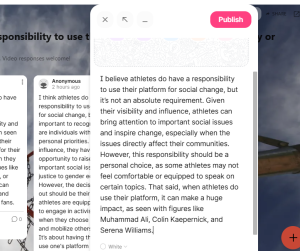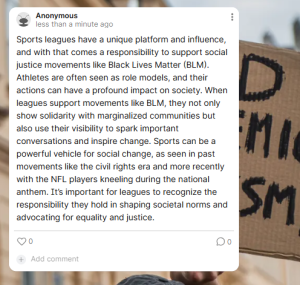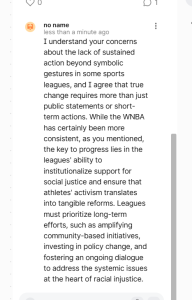 I believe athletes do have a responsibility to use their platform for social change, but it’s not an absolute requirement. Given their visibility and influence, athletes can bring attention to important social issues and inspire change, especially when the issues directly affect their communities. However, this responsibility should be a personal choice, as some athletes may not feel comfortable or equipped to speak on certain topics. That said, when athletes do use their platform, it can make a huge impact, as seen with figures like Muhammad Ali, Colin Kaepernick, and Serena Williams.
I believe athletes do have a responsibility to use their platform for social change, but it’s not an absolute requirement. Given their visibility and influence, athletes can bring attention to important social issues and inspire change, especially when the issues directly affect their communities. However, this responsibility should be a personal choice, as some athletes may not feel comfortable or equipped to speak on certain topics. That said, when athletes do use their platform, it can make a huge impact, as seen with figures like Muhammad Ali, Colin Kaepernick, and Serena Williams.
3
Section One: The Fundamentals
A) Keywords
Exercise 1:
Briefly (in 100 words or less) define one of the keywords in the padlet (including one that you. may have added yourself).

Critical Race Theory: Critical Race Theory is an intellectual movement and framework that examines how race and racism intersect with law, society, and power. It challenges the idea that racism is just an individual issue, arguing instead that it is systemic and embedded in legal, social, and economic structures. CRT emphasizes the lived experiences of marginalized racial groups and promotes the idea that racism is not just about overt discrimination but also about subtle, everyday practices. It advocates for recognizing and addressing these inequalities to create a more equitable society. CRT also questions traditional legal and historical narratives.
|
B) Representing Race
Exercise 2: Notebook Prompt
In about 50-70 words, consider Joel Bervell’s question: why do we feel the need to extrapolate the athleticism of one Black athlete to all Black people when we do not do the same for white athletes?
Try to think of examples when this happens, making sure to reflect on your own positionality.
| Joel Bervell’s question highlights how society often generalizes Black athletes’ abilities to all Black people, while white athletes aren’t subjected to the same broad expectations. For example, Black athletes like Serena Williams are often stereotyped as naturally gifted in sports, while white athletes like Tom Brady or Michael Phelps are seen as exceptions or outliers. This reflects racial biases and assumptions about inherent ability. Personally, as someone who doesn’t share these racial experiences, I realize how stereotypes can unfairly limit how we view people’s potential across all fields, not just sports.
|
C) Gender, Race & Sport
Exercise 3: Notebook Prompt
What are some strategies for resistance that Rajack and Joseph identify in their article as a means of pushing back against and resisting misogynoir?
| In their article, Rajack and Joseph highlight several strategies for resisting misogynoir, including the creation of counter-narratives that challenge harmful stereotypes about Black women. They emphasize the importance of community solidarity, where Black women support one another in resisting oppression. Another strategy is advocating for better representation of Black women in media and influential spaces to ensure their voices are heard. These strategies help Black women reclaim their narratives and push back against the intersectional racism and sexism they face.
|
Section Two: Making Connections
A) Athlete Activism
Exercise 3: Padlet Prompt
Do athletes have a responsibility to use their platform for social change? Why or why not? Please remember to record your response in both the padlet below and in your Notebook.
B) Athlete Activism & Feminism
Exercise 4: Complete the activities

Exercise 5: Notebook Prompt
What do the authors of the article call for as a way of challenging how mainstream sports journalism privileges neoliberal feminist concerns? (100 words max.)
| The authors call for a shift in sports journalism to move away from privileging neoliberal feminist concerns, which focus on individual empowerment and market-driven success, toward a more intersectional approach. This would involve addressing the systemic inequalities in sports, particularly those affecting marginalized women of color. They argue for a focus on collective resistance and social justice, challenging mainstream narratives that ignore issues of race, class, and broader structures of power. By doing so, sports journalism could provide a more inclusive and critical lens on gender and power dynamics in sports.
|
C) Corporate social justice
Exercise 6: Padlet Poll
Read this story by Ramsey Khabbaz contrasting the NFL stance on athlete activism with that of the NBA, especially in regards to BLM. Do sports leagues hold when it comes to BLM? Please respond to the padlet poll and record a brief rationale for your answer there in the space below. Remember to respond collegially to a classmate’s point (you may need to circle back at a later time if you are one of the first to post).
 
|
Section Three: Taking a shot
Module Assignment (submit as part of notebook and separately through Blackboard mini assignment #1 portal)
Analysis of Athlete Activism in The Last Dance
In The Last Dance, Michael Jordan is portrayed as not only a basketball icon but also as a complex figure navigating race, activism, and sports. Although Jordan is not overtly political during his career, the series brings to light his stance on activism, particularly in the 1990s, when the African American community, including athletes, was increasingly using their platforms to speak out on social issues. In the documentary, Jordan is quoted as saying, “Republicans buy sneakers too,” in response to calls for him to support a Black political candidate in North Carolina. This statement was a major point of discussion regarding athletes using their voices for political matters.
Athletes, especially those who are racialized, often face backlash when they take stances on sensitive social issues. Jordan’s strategy in the documentary is to remain apolitical, focusing on his career and brand. However, this neutrality has been criticized as a strategy that prioritizes financial success over social change. The commentary on athletes’ use of their voices in The Last Dance shows the complex balancing act they must perform: while their platform gives them immense influence, the commercial pressures of sports often push them to remain silent or non-committal, as seen with Jordan’s reluctance to publicly endorse a Black candidate.
Race and identity play a huge role in Jordan’s representation. As a Black athlete at the peak of his career, Jordan’s actions (or inactions) were viewed through the lens of race. In a country where Black athletes are often expected to be voices for social change, Jordan’s apolitical stance raised questions about the role of race in shaping athletes’ activism. In relation to the week’s reading from Tested by Rose Eveleth, we see a parallel in how race and gender impact athletes’ actions. Eveleth discusses how women in sports are often forced to prove their worth and navigate expectations of behavior, and in a similar way, racialized athletes like Jordan are tasked with balancing their activism with their commercial interests. This tension between using one’s platform and maintaining financial success shapes how we view athletes and their involvement in social movements.
Through this portrayal of Jordan in The Last Dance, the documentary brings attention to the challenges Black athletes face in choosing to speak out and how their race can complicate the balance between personal beliefs and professional obligations. It forces the audience to consider how societal pressures on race and identity shape the way athletes are expected to engage with activism.

